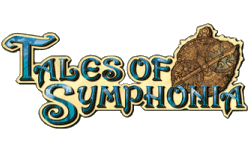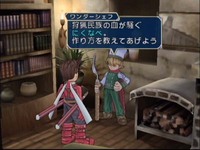|
|

|
PLATFORM
|
GameCube
|
BATTLE SYSTEM
|

|
INTERACTION
|

|
ORIGINALITY
|

|
STORY
|

|
MUSIC & SOUND
|

|
VISUALS
|

|
CHALLENGE
|
Adjustable
|
COMPLETION TIME
|
40-60 Hours
|
|
OVERALL

|
+ Transition to 3D works perfectly.
+ Smooth, streamlined controls.
+ Fantastic story with a great cast of characters.
+ Sharp, colorful visuals.
+ Excellent level design.
- No voice acting during skits.
|
Click here for scoring definitions
|
|
|
I know what you're thinking. About damn time, right? If you've followed anything I've written over the past three years, you should know that I don't hide the fact that Tales of Symphonia is, by far, my all-time favorite game. I've played through it more times than I can count, and now, finally, I've decided to review it. But I ask you, please don't write this off as a fanboy raving about his favorite game, because like any game, Tales of Symphonia does have its issues, insignificant though they may be. There is a reason — in fact, a lot of reasons — that Symphonia has managed to remain at the top of my list for six years: it really is a fantastic game, one that transcends console generations and remains as enjoyable today as it was six years ago.
Tales of Symphonia begins in the small village of Iselia, where an oracle has just arrived that marks the beginning of the Chosen's journey of world regeneration. The Chosen, a young girl named Colette, is destined to save the world. However, Symphonia follows the journey of Lloyd Irving, a brash youth and Colette's childhood friend, who's costly mistake sees him exiled from the village and following the girl on her journey. What begins as a rather cliché "save the world" story takes numerous twists and turns and winds up being a surprisingly poetic tale that deals with themes of racism, sacrifice, and the hazy line between good and evil. The plot is rock-solid and littered with terrific foreshadowing that provides hints at future events, but doesn't give anything away.
But beyond the plot, it's really the characters that make Tales games so enjoyable, and Symphonia is no different. In addition to a great ensemble of main characters, the game features a large and memorable supporting cast and a terrific slew of villains that range from insane to entirely sympathetic. Of particular note is the game's main villain and final boss, whose name I won't mention. It's incredibly rare for a video game to present of villain of the caliber seen here. He is not only easy to sympathize with, but as the game progresses, you may even begin questioning whether or not you're on the right side. The story and characters are all tied together through dozens of skits and side quests that help flesh out the world and their back stories.
 The cel-shaded visuals are a sight to behold.
The cel-shaded visuals are a sight to behold.
|
|
Tales of Symphonia's skits are actually a fairly prominent element of the story. There are over one hundred in the game, activated when certain conditions are met, and they provide amusing character interactions and story enhancements that can punctuate sections of extended gameplay. They are displayed simply through a series of animated character portraits and text, and unfortunately the voice acting present in the Japanese version has been removed, but they still manage to add quite a bit to the game.
While the story provides the drive, the gameplay provides the meat, and Tales of Symphonia is one of the most polished games in the series. Taking the first step into 3D, Symphonia continues using the series trademark Linear Motion Battle System, but it's been upgraded to take place in a 3D space. While ally characters and enemies, controlled by the computer, can move around in full 3D, the player controlled character is, as always, restricted to a straight line between him and the enemy. While this makes movement somewhat restricted, changing targets also changes the position of the line, and in this way the player has full range of the battlefield. Although the core gameplay remains true to the earlier Tales titles, it has been smoothed out and streamlined to the point where the controls are near-perfect in their responsiveness.
It's outside of combat that Tales of Symphonia brings in new enhancements and features to the series, and there are dozens of them. Random encounters have been removed entirely in favor of enemies appearing on the map, and the Sorcerer's Ring, a device used for puzzle solving in previous games, has become one of the forefront mechanics showcased in the game. It's acquired almost immediately, and is used in dozens of creative ways throughout the game, creating the best puzzles and dungeons in the series. In each dungeon, a special device changes the ring's functionality from its default fireball to some new and interesting power, everything from electrical balls to animal-summoning sound effects. It can even be used to freeze enemies on the map screen, a mechanic introduced briefly in Eternia, which makes avoiding unwanted encounters a breeze.
Character development has also received some interesting enhancements. As the game progresses, players will discover objects called EX-Spheres. Up to four of these can be equipped to each character, and each one allows the player to choose from four different combat-enhancing effects. With four different grades of quality, that makes for a total of sixteen to choose from. Further, different combinations of EX-Skills can yield unexpected bonus effects, encouraging experimentation. Finally, each EX-Skill is either of the technical or strike type, and focusing a character on a specific type alters the moves they learn as they level up. The system is simple to understand and play around with in the game, but can provide plenty of customization options.
 The Wonder Chef makes his glorious return!
The Wonder Chef makes his glorious return!
|
|
Even with everything that Tales of Symphonia does well, without question one of its most impressive aspects is its visuals. Featuring one of the earliest implementations of cel-shading, Symphonia's visuals are crisp, vibrant, and colorful. Even more impressive is how well they hold up, even today. While most games of the GameCube and PlayStation 2 era tend to look quite awful on high-definition TVs, Symphonia looks spectacular. Its visuals hold up far better than Legendia or Abyss, and it even manages to trump the recently released Dawn of the New World, which was tailor-made for the Wii. Only the Xbox 360's Vesperia manages to top it, and that's an impressive feat for a six year old game.
Symphonia's audio suffers from a few more hiccups, but still manages to be very good. Motoi Sakuraba's score is solid, but many tracks are rearranged versions of ones from Tales of Phantasia. The instrumentation is of higher quality than the PS1 Tales titles, so the soundtrack manages to sound much better than his prior works. The voice acting is also very good, although it falters fairly regularly. Much of this is due to awkward dialogue rather than poor acting.
When we think of classic RPGs, we generally think back to the days of the Super Nintendo or the original PlayStation: games like Chrono Trigger, Secret of Mana, or Final Fantasy VII. Tales of Symphonia is a modern classic. Everything about it holds up so well, even after six years of innovation. Symphonia is the Tales game that everyone will remember, and it's a game that everyone should experience.
Review Archives
|









